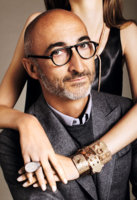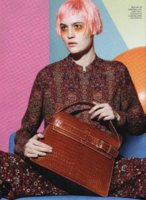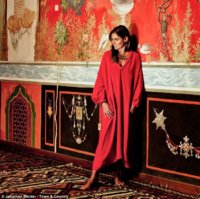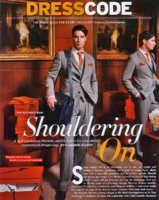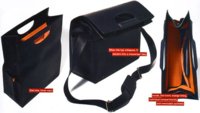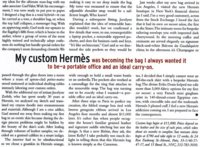The Genius of Pierre Hardy (ELLE)
Pierre Hardy is allergic to horses. He has never gone riding, doesnt hunt, and avoids the countryside whenever possible. For most designers, such aversions wouldnt matter, but they present supreme paradoxes for anyone in charge of shoes and jewelry for Hermès, the French house that began in 1837 as a harnessmaker and is still synonymous with luxe equestrian chic. Fortunately, with Hardys heightened creative powers, hanging around stables doing research is hardly necessary.
A photo of a horse can be just as inspiring to me as a real horse, Hardy says. Just the idea I have of horses is enough. I believe a lot in the imagination.
Thats apparent to anyone familiar with Hardys workwildly inventive jewels, shoes, and bags that have a way of being elegant and eye-popping in equal measure. Among his recent pieces for Hermès, where hes overseen jewelry for the past decade, are the vaguely naughty Fouet riding whip necklaces; the platinum version, studded with 3,669 tiny diamonds, costs $890,000. His shoe designswhether for Hermès, his own namesake line, or Balenciaga, in collaboration with Nicolas Ghesquièreare fun but resolutely unfrivolous, balancing a disciplined, almost architectural purity with a quirky boldness that has earned him legions of feverishly obsessed fans among fashions smart-girl set. Although Hardy doesnt quite have the name recognition of a Louboutin or a Blahnik, his sleek, graphic aesthetic has had an enormous ripple effect, as has his mastery of the skyscraper heels that have dominated runways in recent years. His most boundary-pushing looks, such as the strikingly sci-fi Lego shoe that he and Ghesquière showed in 2007, leave women asking two questions: First, Is that really a shoe? And second, Where can I buy it?
Hardy, a onetime contemporary-dance student born and raised in Paris, discovered the thrill of testing limits as a teenager. In dance you push yourself to go just as high or as far as you can, while staying in balance, says the designer, who at 55 is still spry and boyishly thin, wearing, on the day we meet, white jeans and suede desert boots from his mens line. Its kind of like a drug, to know how far you can go. Mental gymnastics also came naturally to Hardy, who studied fine art at Frances prestigious École Normale Supérieure and later worked as a fashion illustrator before Dior hired him to design womens shoes in 1987. He still teaches at another Paris art school and discusses shapes, colors, and materials like a professor. There are purely formal questions that always interest me, Hardy says. What shape are we going to give to a heel? Why a cone, why a ball, why a cube?
For Hermès Haute Bijouterie collection, shown for the first time in the U.S. this fall, Hardy was inspired not just by the horsewhip but also by the lowly hoof. Of the gracefully chunky Centaure ring, which can be ordered in various combinations of gold, diamonds, aventurine, white coral, and black jade, Hardy explains in his rapid-fire speech: The idea was to take this thing that is the most animalistic and brutish part of a horse and to pare it way, way down, until its almost a geometric volumebut you still recognize it. Meanwhile, Hardys latest riff on a classic Hermès bracelet is about as understated as a diamond pavé dog-collar cuff can be.
Hardys spring 2008 shoes for Gap exposed an entirely new audience to his stack-heel platforms and lace-up ankle boots. For his own line, one recent statementmaker was the Skyline sandal, with its dazzling cluster of metallic rectanglesintroduced, fittingly, at his new West Village, New York, store last December. But his most buzzworthy work to date has arguably been with Balenciaga. Rather than basing his shoe designs directly on Ghesquières clothes or sketches, Hardy maintains a constant dialogue with the designer about textures, materials, and volumeseven if his inspirations sometimes come from way beyond the Balenciaga atelier. The Lego shoe, for example, grew out of some snowboard bindings Hardy spotted in a ski store in New York. The two men have been close for 20 years and were once a couple; its clear Hardy believes that Ghesquière stands alone among todays designers. Nicolas invents a new silhouette each time, a new way of working with the materials, almost creating a new body, in a way, he says. Ghesquière, asked about Hardys unique point of view, mentions similar tendencies. With Pierre there is always a potent mix of historical knowledge and the ultracontemporary, Ghesquière says. And a great spectrum of inspirationsit could be modernism, design, art, but most importantly, everything is totally twenty-first century.
At his Paris apartment, Hardys wide-ranging tastes are evident in the black-and-white 1970s Ettore Sottsass ceramics, the geometric furniture by Konstantin Grcic, and the phantasmagorical ink drawings of French artists Mrzyk and Moriceau. Though some in the fashion world have gone as far as to brand Hardy himself an artist, he dismisses the notion with one of his frequent deep laughs. Fashion is a product, Hardy says. Accessories are made to be bought and sold, just like plates or sofas. But within that register, I try to make things with the greatest degree of creativity and personality. His 2012 collection of Haute Bijouterie will, he notes, be differentradically. It may be part of his job to build on classics and respect traditions, but you also have to reinvent certain things, Hardy says. And maybe someday, in 10 years, or a long time from now, they will seem like classics also.
http://www.elle.com/Fashion/Fashion-Spotlight/The-Genius-of-Pierre-Hardy


